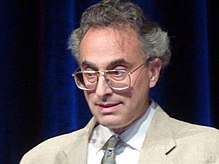Michael J. Larsen
Michael Jeffrey Larsen is an American mathematician, a distinguished professor of mathematics at Indiana University Bloomington.[1][2]

Academic biography
In high school, Larsen tied with four other competitors for the top score in the 1977 International Mathematical Olympiad in Belgrade, winning a gold medal.[3][4] As an undergraduate mathematics student at Harvard University, Larsen became a Putnam Fellow in 1981 and 1983.[5] He graduated from Harvard in 1984,[6] and earned his Ph.D. from Princeton University in 1988, under the supervision of Gerd Faltings.[7] After working at the Institute for Advanced Study he joined the faculty of the University of Pennsylvania in 1990, and then moved to the University of Missouri in 1997.[6] He joined the Indiana University faculty in 2001.[1]
Research
Larsen is known for his research in arithmetic algebraic geometry, combinatorial group theory, combinatorics, and number theory.[1][2] He has written highly cited papers on domino tiling of Aztec diamonds,[8] topological quantum computing,[9][10] and on the representation theory of braid groups.[11]
Awards and honors
In 2013 he became a fellow of the American Mathematical Society, for "contributions to group theory, number theory, topology, and algebraic geometry".[12] He received the E. H. Moore Research Article Prize of the AMS in 2013 (jointly with Richard Pink).
Selected publications
- Elkies, Noam; Kuperberg, Greg; Larsen, Michael; Propp, James (1992), "Alternating-sign matrices and domino tilings. I", Journal of Algebraic Combinatorics, 1 (2): 111–132, arXiv:math.CO/9201305, doi:10.1023/A:1022420103267, MR 1226347.
- Freedman, Michael H.; Larsen, Michael; Wang, Zhenghan (2002a), "A modular functor which is universal for quantum computation", Communications in Mathematical Physics, 227 (3): 605–622, Bibcode:2002CMaPh.227..605F, doi:10.1007/s002200200645, MR 1910833.
- Freedman, Michael H.; Larsen, Michael J.; Wang, Zhenghan (2002b), "The two-eigenvalue problem and density of Jones representation of braid groups", Communications in Mathematical Physics, 228 (1): 177–199, arXiv:math/0103200, Bibcode:2002CMaPh.228..177F, doi:10.1007/s002200200636, MR 1911253.
- Freedman, Michael H.; Kitaev, Alexei; Larsen, Michael J.; Wang, Zhenghan (2003), "Topological quantum computation", Bulletin of the American Mathematical Society, 40 (1): 31–38, arXiv:quant-ph/0101025, doi:10.1090/S0273-0979-02-00964-3, MR 1943131.
References
- Dawson, Kate (March 6, 2011), "IU gives 5 faculty rank of distinguished professor", Indiana Daily Student.
- Michael J. Larsen, IU News Room, March 30, 2011.
- Shenker, Israel (July 14, 1977), "High School Math Wizards Do It by Numbers and U.S. Is No.1", New York Times.
- International Mathematical Olympiad 1977 (Belgrade, Yugoslavia) Individual Scores, Joseph Myers, polyomino.org.uk, retrieved 2012-08-16.
- The Mathematical Association of America's William Lowell Putnam Competition, Mathematical Association of America, retrieved 2012-08-16.
- Member biography, Indiana U. Alliance of Distinguished and Titled Professors, retrieved 2012-08-16.
- Michael Jeffrey Larsen at the Mathematics Genealogy Project
- Elkies et al. (1992).
- Freedman, Larsen & Wang (2002a); Freedman et al. (2003).
- Klarreich, Erica (February 22, 2003), "Knotty calculations: a quantum version of braids could lay the groundwork for tomorrow's computers", Science News.
- Freedman, Larsen & Wang (2002a).
- 2014 Class of the Fellows of the AMS, American Mathematical Society, retrieved 2013-11-04.
External links
- Home page at Indiana University